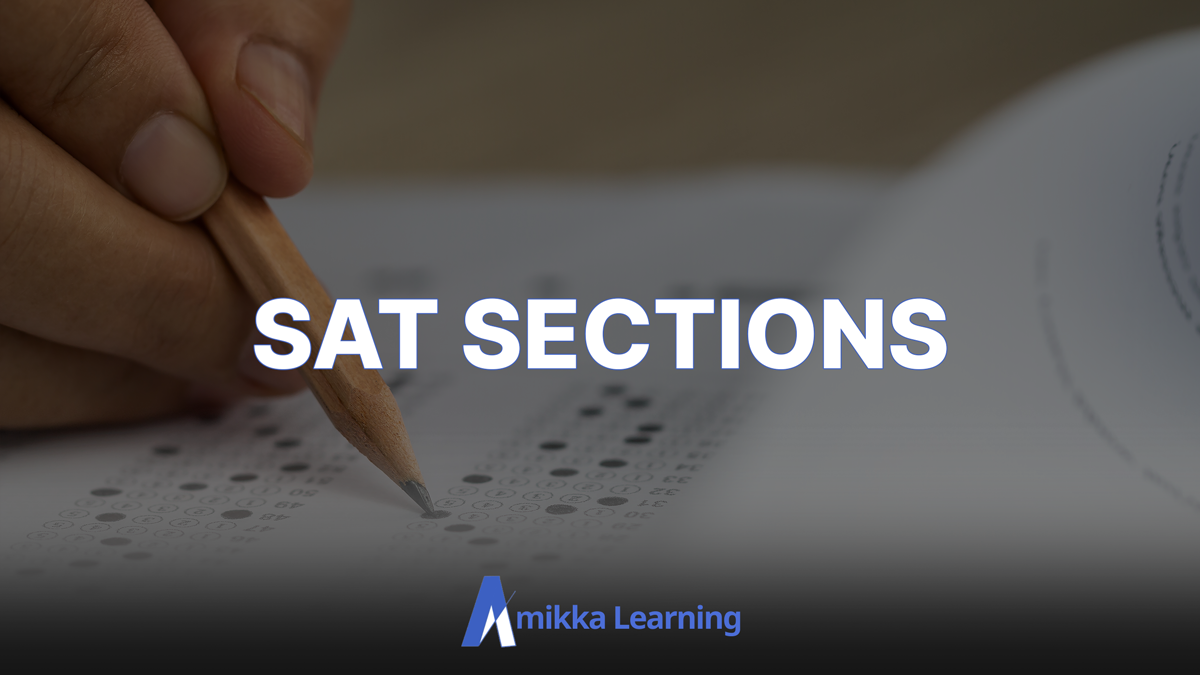


Written by Chris Hernandez
The SAT, which used to be known as the Scholastic Aptitude Test and later became the Scholastic Assessment Test, is a widely used standardized test for college admissions in the United States. In 2016, the organization in charge of the SAT, the College Board, dropped the acronym and simply referred to it as the SAT.
By taking the SAT, you are indicating that you are ready to leave high school and move on to college. Although the test may appear intimidating, the more you know about it, the more manageable it will be. This article provides insight into the five main sections of the SAT.
The SAT is composed of sections that test your understanding of high school-level reading, writing, and math.
The reading portion of the exam tests your comprehension and understanding of literary and historical topics, while the writing section examines your aptitude in grammar and communication.
The math section looks at your understanding of basic algebra and statistics, as well as some more complex math.
There are actually 2 primary sections each with 2 subsections, and an optional essay, making up 5 sections:
Note: As of September 2021, the College Board no longer offers the SAT essay section. It is surprising to note that compared to before, most prestigious universities no longer require the SAT essay. None of the Ivy League Schools, Stanford, Caltech, Duke, Georgetown, Johns Hopkins, MIT, Northwestern, NYU, and UChicago, require the SAT essay at present. Furthermore, many of these universities have stopped suggesting students take the SAT with an Essay, which is a considerable change from a couple of years ago.
Let's go over each section in-depth.
This is the first section of the test, consisting of 52 questions to be answered in 65 minutes.
The SAT Reading Test consists of multiple-choice questions that focus on testing comprehension, critical reading, and rhetorical skills.
Having prior knowledge of the content can be beneficial and high school literature and history classes may help prepare you.
Additionally, reading the questions before the passage can help make the test easier and save time for review.
The test also includes questions that require synthesis-based skills, such as interpreting graphs and coming to specific conclusions about a passage.
The 52 questions are associated with 5 passages of varying length. Each passage comes with 9 to10 questions, typically from the following genres:
The Evidence-Based Reading section will require students to focus on the most important points of each passage to answer the questions:
This table shows the question types students can expect in the SAT Evidence Based Reading test:
| Question Type | Number of Questions |
| Function / Purpose | 8 to 12 questions |
| Vocabulary in Context | 6 to 8 questions |
| Command of Evidence | 8 to 10 questions |
| Detail | 5 to 8 questions |
| Charts & Graphs | 2 to 4 questions |
| Main Idea | 4 to 6 questions |
| Character Analysis | 2 to 4 questions |
The SAT Reading section doesn't require any content knowledge, which makes it different from Math and Writing & Language. It is based on strategies, so it is important that students use evidence to support the answers they choose. Don't forget that it is called the Evidence-Based Reading section for a reason!
To reinforce this process, the College Board has even incorporated a question type–Command of Evidence.

Source: The College Board Official Practice Test 1
This section is the second part of the SAT, consisting of 44 multiple-choice questions to answer in 35 minutes.
This section of the SAT assesses your ability to revise and edit written English, requiring you to identify and correct any mistakes in sentence structure, punctuation, grammar, and usage.
It features 44 multiple-choice questions based on four passages, which involve testing your grammar, vocabulary, and general English language arts skills.
Here is where your mastery of SAT vocabulary is useful, since having more knowledge will be beneficial.
This multiple-choice section will ask you questions about passages from academic papers, like how to best improve a sentence, correctly interpret data from graphs and other figures, or distinguish between informative and persuasive writing styles.
Unlike the Reading section, questions occur throughout each passage, rather than at the end.
Here’s what students can expect to see:

Source: The College Board Official Practice Test 1
The Writing & Language section of the test needs students to have knowledge of the subject and an awareness of writing principles that are effective.
Consequently, it can be expected that half of the 44 questions will ask about grammar and punctuation. The remaining half will be related to writing tactics that are useful, such as crafting successful introductions and conclusions, using words that transition well, and analyzing evidence.
Here's what students can expect to be tested on in the SAT Writing & Language section:
The Math – No Calculator section is the first and shortest section of the SAT Math test. This section of the exam requires you to answer 20 multiple-choice questions in 25 minutes without the use of a calculator. Your comprehension of mathematical concepts, your interpretation of equations and expressions, and your problem-solving skills will all be tested.
The SAT Math section is designed so that the questions become progressively more difficult as you go through them. Wise test takers can use this to their advantage by attempting the earlier, easier questions first. Even though it might sound intimidating, it is possible to answer all the questions in the No-Calculator section without the use of a calculator.
15 of the questions are standard multiple-choice formats, and the final 5 questions are grid-in questions. Students must supply their own answers in the provided grid.

This table shows the 4 content areas of the SAT Math – No Calculator test:
| Content Area | Number of Questions | Including |
| Algebra | 8 to 10 | Fractions, Single Equations, Simplification, Substitution, Percentages, Inequalities |
| Geometry | 2 to 4 | Triangles, Circles, Volume / Area |
| Trigonometry | 0 to 2 | |
| Advanced Math* | 6 to 10 | Factoring, Polynomials, Systems of Equations, Translating Words into Math, Fractions, Ratios, Functions, Substitution, Imaginary Numbers, Square Roots |
*The College Board calls these questions “Passport to Advanced Math” questions. Many of these can be classified as advanced algebra questions.
This Math – Calculator section is composed of 38 multiple-choice questions that you will have 55 minutes to answer. A calculator is allowed for this section, which evaluates your understanding of arithmetic, algebra, and geometry, even though the questions are more complex than in the Math – No Calculator section. The main difference is the number of specific content areas that are tested. Similar to the Math – No Calculator section, the questions go from easiest to hardest. The initial 30 questions are multiple-choice and the last 8 are grid-in questions.
The Calculator portion of the SAT Math section is more heavily focused on data analysis, often using Charts and Graphs. Although algebra is still a major part of the exam, there are fewer questions related to geometry and trigonometry. The SAT Math section is also known for being quite wordy and demanding a lot of translation and problem-solving skills. This is because the College Board wants to give students a more realistic math experience.
This table illustrates the focused content types.
| Content Area | Number of Questions |
| Geometry | 3 to 6 questions |
| Data Analysis & Problem-Solving | 16 to 18 questions |
| Algebra | 10 to 13 questions |
| Advanced Math | 5 to 8 questions |
Most students can no longer take the optional SAT essay as part of their overall exam. As of September 2021, the College Board no longer offers the SAT essay section.
Nevertheless, certain states may mandate that students take the essay part of state-mandated SAT testing, including:
The essay must be written in response to a brief passage and be between 650 and 750 words, which must be completed in 50 minutes.
Taking the essay allows students to showcase their writing and persuasive skills. The reading prompt will be unique to the test day, but the response should always be to explain how the author used evidence and reasoning to make a convincing argument, and include which types of argument they employed, such as logos, pathos, or ethos.
If you decide to take the SAT Essay, it will not have any bearing on your Verbal score. Your Essay score will be displayed in a separate part of your score report and will be judged independently.
The SAT Essay task is always the same. The only thing in the prompt that changes is the author’s name:

After students read and analyze a passage, they must write a response that discusses how the author formulates a persuasive argument.
Here’s the specific prompt:

Note: Along with offering the best 1-on-1 tutors for private lessons, Amikka Learning created over 1,000 test prep videos to help students improve even faster. Move from beginner to expert level at lightning speed. Contact Amikka Learning for a free trial now!
The SAT is a timed test, although testing accommodations are available for select students. It is essential to be aware that the SAT is a regularized assessment, meaning the layout and material of the exam are identical from one sitting to the next.
To succeed on the SAT, you should be acquainted with the structure of the test and the types of questions in each section. Additionally, you should practice your test-taking tactics and manage your time carefully to get the best possible score.